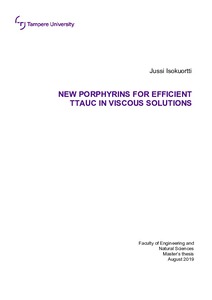New Porphyrins for Efficient TTAUC in Viscous Solutions
Isokuortti, Jussi (2019)
Isokuortti, Jussi
2019
Teknis-luonnontieteellinen DI-ohjelma - Degree Programme in Science and Engineering
Tekniikan ja luonnontieteiden tiedekunta - Faculty of Engineering and Natural Sciences
This publication is copyrighted. You may download, display and print it for Your own personal use. Commercial use is prohibited.
Hyväksymispäivämäärä
2019-08-19
Julkaisun pysyvä osoite on
https://urn.fi/URN:NBN:fi:tuni-201908122869
https://urn.fi/URN:NBN:fi:tuni-201908122869
Tiivistelmä
Triplet-triplet annihilation upconversion (TTAUC) is an efficient process for photon upconversion: low energy light is absorbed and high energy light is emitted by the system. In this work, two different porphyrins, zinc and palladium tetraarylphthalimidoporphyrin (Zn and PdTAPIP), were utilized as sensitizers in TTAUC in two different viscous solvents, PEG200 and PEG300, providing viscosities of 54 and 520 cP, respectively. These high viscosity solvents were utilized as model systems for polymer matrices, such as micelles. High molar absorption coefficient and long triplet state lifetime of both porphyrin make them attractive for TTAUC. The performance of both porphyrin in both solvent was evaluated by determining quantum yield of upconversion and power density threshold. The properties of the porphyrins were additionally characterized by absorption, luminescence and quenching studies.
The thesis consists of two main parts. The first part is a literacy review of TTAUC divided into three chapters. The introduction takes a general look at photon upconversion and presents some applications and uses of TTAUC. Second and third chapters delve into the physical mechanisms and processes of TTAUC and the requirements for efficient TTAUC. Second part presents the experimental methods and measurement setups used to obtain the results that are shown and discussed in the last two chapters of the work.
This thesis establishes that both Zn and PdTAPIP are able to sensitize efficient TTAUC proven by high quantum yields of upconversion, low power density thresholds and large upconversion energy shifts even in viscous environments. PdTAPIP is capable of sensitizing TTAUC with slightly higher quantum yield and lower power densities than ZnTAPIP, the maximum quantum yield being 33 % in PEG200. However, after suppressing reverse triplet-triplet energy transfer, ZnTAPIP presents an intriguing case of efficient upconversion with 26 % quantum yield in PEG while exhibiting considerably endothermic energy transfer over a 3 kBT energy gap resulting in large upconversion energy shift of 0,89 eV. With so high quantum yields and large upconversion energy shifts both porphyrin can be regarded as a state of the art sensitizer for TTAUC.
The thesis consists of two main parts. The first part is a literacy review of TTAUC divided into three chapters. The introduction takes a general look at photon upconversion and presents some applications and uses of TTAUC. Second and third chapters delve into the physical mechanisms and processes of TTAUC and the requirements for efficient TTAUC. Second part presents the experimental methods and measurement setups used to obtain the results that are shown and discussed in the last two chapters of the work.
This thesis establishes that both Zn and PdTAPIP are able to sensitize efficient TTAUC proven by high quantum yields of upconversion, low power density thresholds and large upconversion energy shifts even in viscous environments. PdTAPIP is capable of sensitizing TTAUC with slightly higher quantum yield and lower power densities than ZnTAPIP, the maximum quantum yield being 33 % in PEG200. However, after suppressing reverse triplet-triplet energy transfer, ZnTAPIP presents an intriguing case of efficient upconversion with 26 % quantum yield in PEG while exhibiting considerably endothermic energy transfer over a 3 kBT energy gap resulting in large upconversion energy shift of 0,89 eV. With so high quantum yields and large upconversion energy shifts both porphyrin can be regarded as a state of the art sensitizer for TTAUC.
